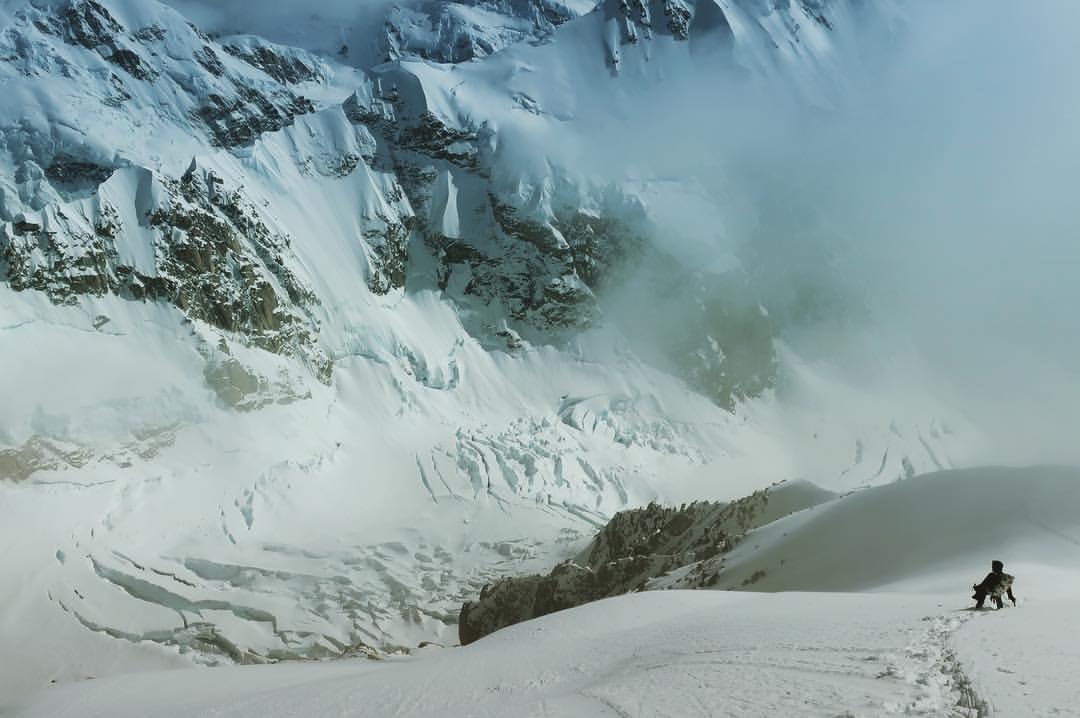
Digging in for another unexpected bivy, this time at 17,300 feet, I read our fate via inReach satellite message:
70mph winds are forecasted over the next two days. Make sure you sink a picket or screws and tie into that shit. Don’t go Wizard of Oz on us.
I couldn’t help but laugh. My partner Sam Novey and I were on day six of a planned three-day climb of Denali’s Cassin Ridge. We were out of food and had already endured some of the worst weather either of us had experienced in the mountains. Cold and alone on the South Face of Denali, our spirits remained high. We smiled and sang our favorite Beastie Boys tune, drowned out by freight-train winds.
The Father and Sons Wall, a subsidiary peak of Denali on which we dreamed to attempt a new route, was active and out of condition. Massive hangers threatening the wall broke from above, and huge avalanches ripped down the face. We shifted our focus to Denali’s ultra-classic Cassin Ridge. Although not the most difficult route by modern-standards, it is still a test-piece and goal of alpinists worldwide. Moreover, it remains one of, if not the most, classic alpine routes in North America.

Accordingly, the route had been a goal of mine ever since I’d first climbed Denali as a wide-eyed teenager seven years ago. Sam was equally psyched on the Cassin, and especially eager to do some climbing. He had been in Alaska for two weeks prior to my arrival on the Kahiltna glacier with our mutual friend Alan. They spent nearly their whole trip in the tent waiting out horrible weather. When a short window allowed an attempt on the North Buttress of Mt. Hunter (often referred to as the Moonflower), they were forced to retreat in the face of serious avalanche danger.
A second attempt on the face, deciding this time on a variation (Deprivation) in hopes of avoiding the line of fire, also ended in retreat after another near miss. With no reasonable windows of high pressure throughout their trip, they couldn’t even consider their other objective—Mt. Foraker’s Infinite Spur. The beautiful line holds a heavy shadow; Karen McNeill and Sue Knott vanished attempting it in 2006. In 2004, two years before the tragedy on Foraker, the duo survived an epic eight days, complete with a summit bivy, on the nearby Cassin Ridge.
With our objective solidified, we quickly moved all of our gear and food up to the 14,300-foot camp on Denali’s well-traveled West Buttress route. We were happy to ditch the heavy loads divided between sleds and massive packs (standard fare on the West Buttress) in exchange for the 40L CiloGear bags we’d take on the Cassin. I was especially relieved that my back had survived the heavy loads, as I’d undergone back surgery a year prior.
With our advanced base camp at 14k established, we shifted our focus to acclimatizing. We immediately took a trip to high camp (17k) on the West Buttress. After a day’s rest, we put in a booter to the West Rib cutoff at 15,666 feet. We’d decided to approach the Cassin by downclimbing the West Rib (accessed via the Rib cut-off), as opposed to the “standard” (although not standard anymore) and highly dangerous NE Fork of the Kahiltna—aka Valley of Death—approach.

Four days after arriving at 14k Camp, we faced a dilemma. The extended forecasts we’d been getting indicated low pressure over the next week and a half, with a potential storm hitting the range about six days out. The next five days, however, although not the ideal high-pressure system we’d hoped for, looked manageable. We had a choice; launch the next day and climb in marginal but hopefully manageable weather, or wait it out until the next system (our final potential window) and risk a storm—meaning we wouldn’t be able to attempt the route.
After consulting with friends back home, analyzing the weather data, and much deliberation, we decided that this was our window. We relayed our plans to our friend Mark, who was guiding a team up the West Buttress and happened to be camped nearby. We’d launch the next day, packing three days of food and four days of fuel; more than we would have taken if there had been high pressure and if we had more time to acclimatize.
We headed out after a breakfast of pancakes and bacon the next day. After walking up familiar terrain to the West Rib cutoff at 15,666 feet, we began downclimbing the West Rib to its start on the NE Fork—relatively close to the Japanese Couloir that marks the start of the Cassin Ridge. A quick look down a broken and crevassed Seattle Ramp confirmed our decision to continue down the West Rib instead of the Seattle Ramp, which, in good conditions, affords more direct access to the base of the Cassin.
Within five hours of leaving 14k Camp, we’d downclimbed the West Rib and were standing at the base of the entry couloir (the “Chicken Couloir”) at 11,200 feet on the intimidating NE Fork. Aside from punching into a few hidden crevasses, we enjoyed the scenic downclimb and never felt the need to place protection or rig rappels. The weather was splitter, aside from some fog. We moved quickly across the NE Fork’s inherent objective hazards hanging high on either side of the narrow valley. Scurrying through a massive debris field and avoiding cracks in the glacier, we found ourselves at the base of the Japanese Couloir (12,300 feet) less than an hour later. We ate a snack and began simul-climbing.
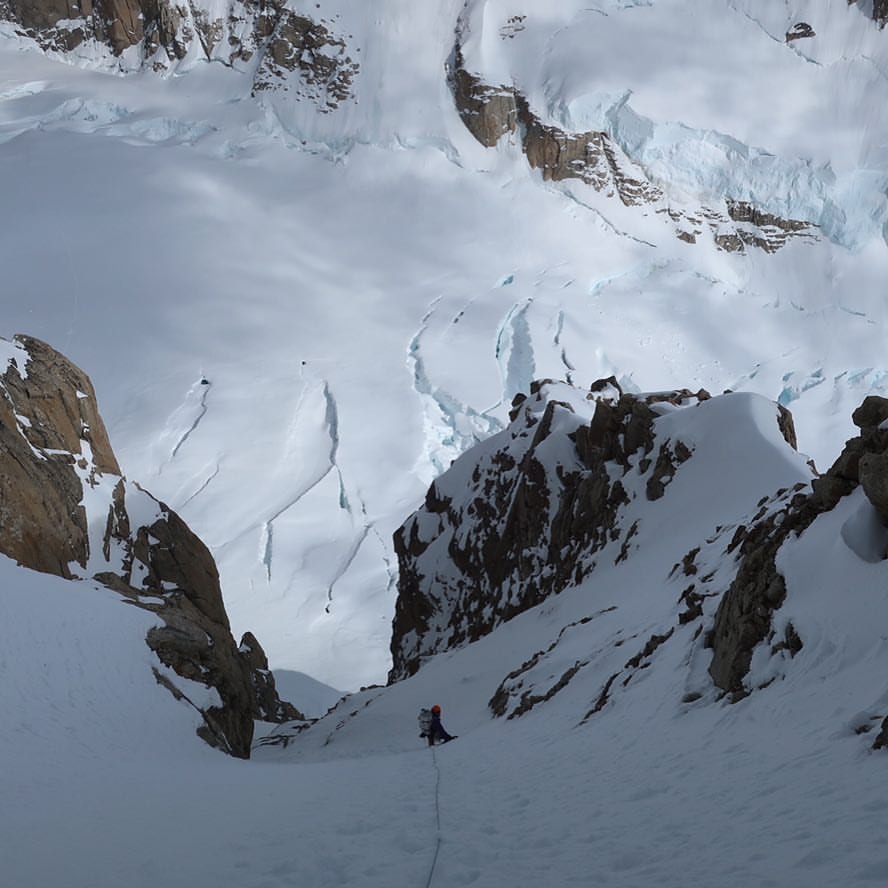
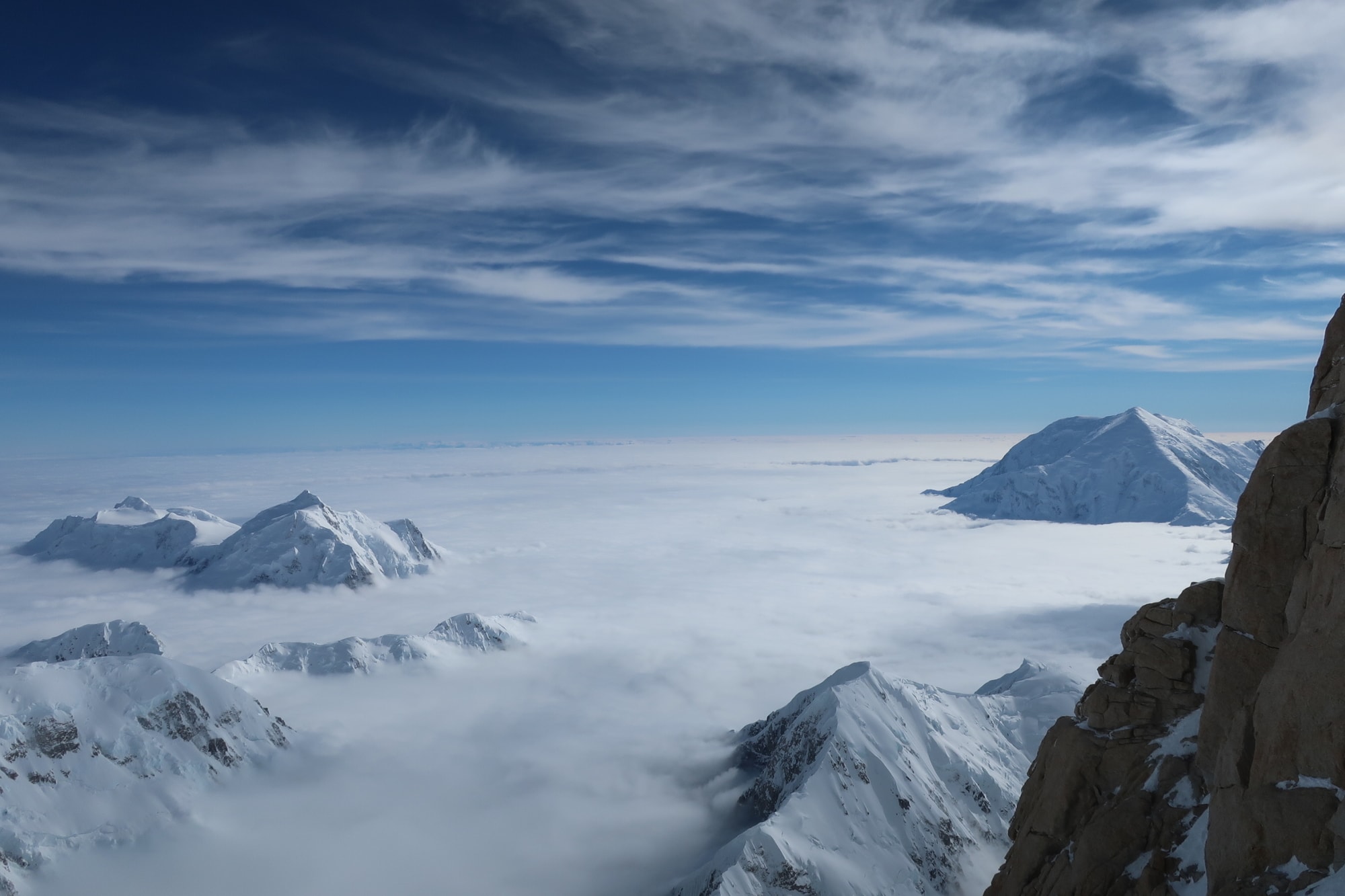
The weather deteriorated as we climbed the couloir, with high winds and heavy spindrift dumping down as we hurriedly approached its apex at the Cassin ledge. Here, we were forced to chop out a platform and pitch our small MSR Advanced Pro tent. Our next decision weighed heavy. If the weather improved enough while we waited and gathered updated forecasts via our inReach that we decided to continue up, we’d be committing to the point of no return. The next pitch was the route’s crux gully (roughly 5.8 mixed), followed by the long and exposed Knife Edge Ridge (aka Cowboy Arete).
Downclimbing this would be dangerous, impossible to protect, and incredibly time-consuming. Our alternative—bailing from the Cassin ledge —would involve over a dozen rappels with our single 50m rope down the Japanese Couloir, walking back across the dangerous NE Fork to the base of the Chicken Couloir, climbing back up to 15,666 feet on the West Rib to the cutoff, and finally walking back to 14k Camp on Denali’s West Buttress.
Fifteen hours later, the weather had improved and we received consistent weather updates from friends confirming a manageable forecast. Sam was confident, and, although hesitant, I trusted our training and knew we’d be able to climb through 40mph winds and light snow. My concern was being pinned past the point of no return if the forecast ended up being worse than that predicted. We’d be stuck with minimal provisions on the massive South Face of Denali, all while the upper avalanche-prone slopes of the Cassin became increasingly loaded.
I rationalized my doubts. The weather would most likely be consistent with that forecasted or even turn out slightly better.
How would I feel if we bailed and missed a rare chance to climb a dream route? What were the odds of a massive storm moving in and pinning us down? We’d roll the dice and find out.
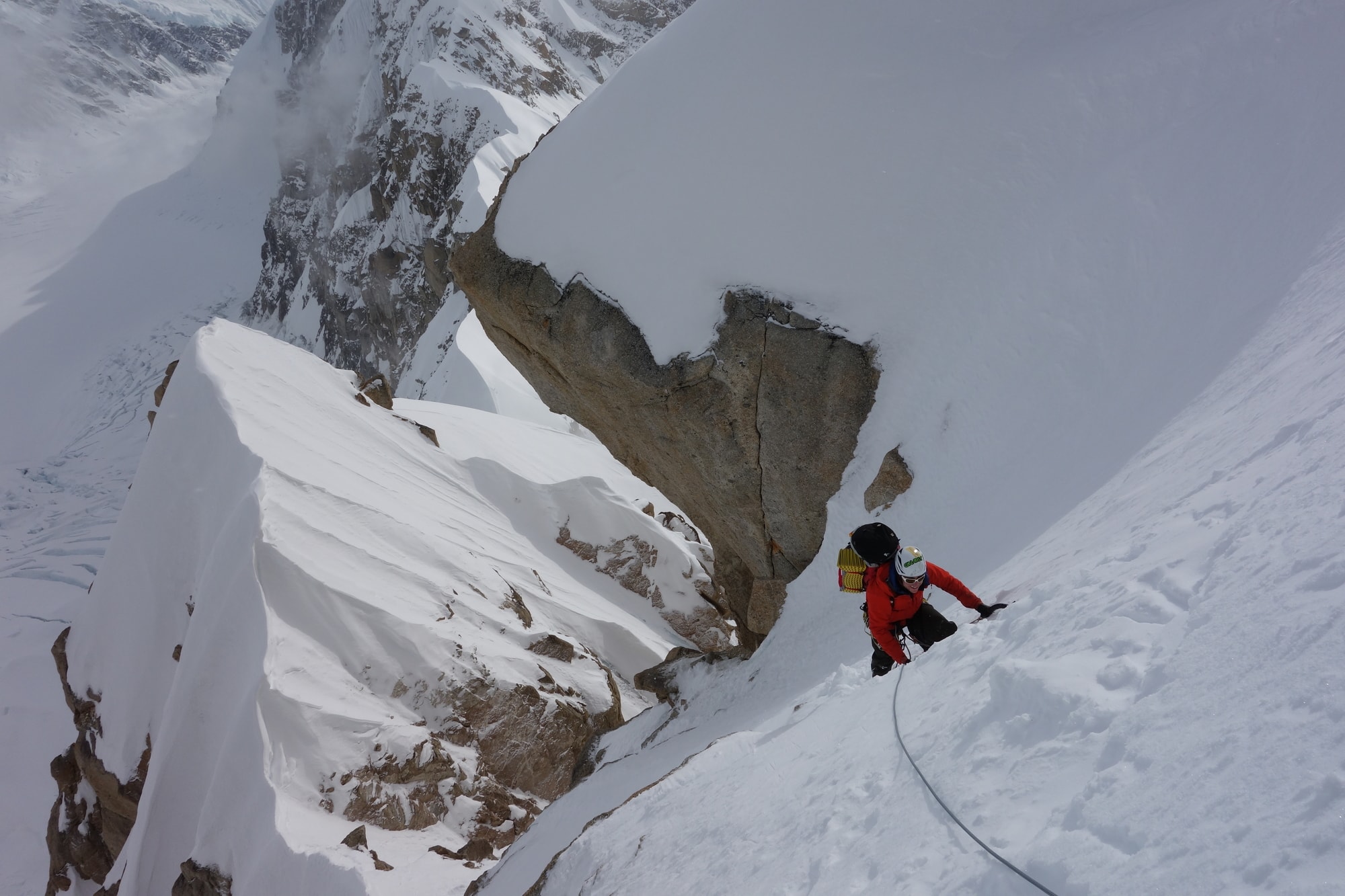
After inadvertently not traversing far enough right and climbing a (supposedly) more difficult crux mixed gully, we started up the Knife Edge ridge. Although exposed and corniced, it wasn’t as daunting as either of us imagined. We simul-climbed its entirety, placing an occasional picket or deeply excavated ice screw.
While on the ridge, we experienced gusts up to 40mph. Thankfully, we usually heard the gusts before they hit, giving us the chance to brace for impact. With no belays in this section, the roughly eight pitches of simul-climbing went by quickly, and we found ourselves at the hanging glacier (at roughly 14,000 feet) as the sun set.
Cold from the exposure and wind on the Knife Edge ridge, we decided to keep moving towards the base of the first rock band. As we slogged up the hanging-glacier, we experienced deteriorating weather and worsening visibility as the Alaska night settled. Never truly dark, the option to climb all day and through the night is one of the many unique aspects of climbing in the Alaska Range. Unable to find a sheltered spot to stop and brew (melt snow into water), we simul’d up into the base of the first rock band.
We found a small perch under a rock overhang on the right-side (near the “M-shaped” rocks) in what was now a full-on storm with minimal visibility. Forced to dig-in and wait until the weather improved, we chopped out a platform just large enough for our tent, and anchored in via ice screws. We enjoyed instant mashed potatoes, updated friends and family via the inReach, and waited.
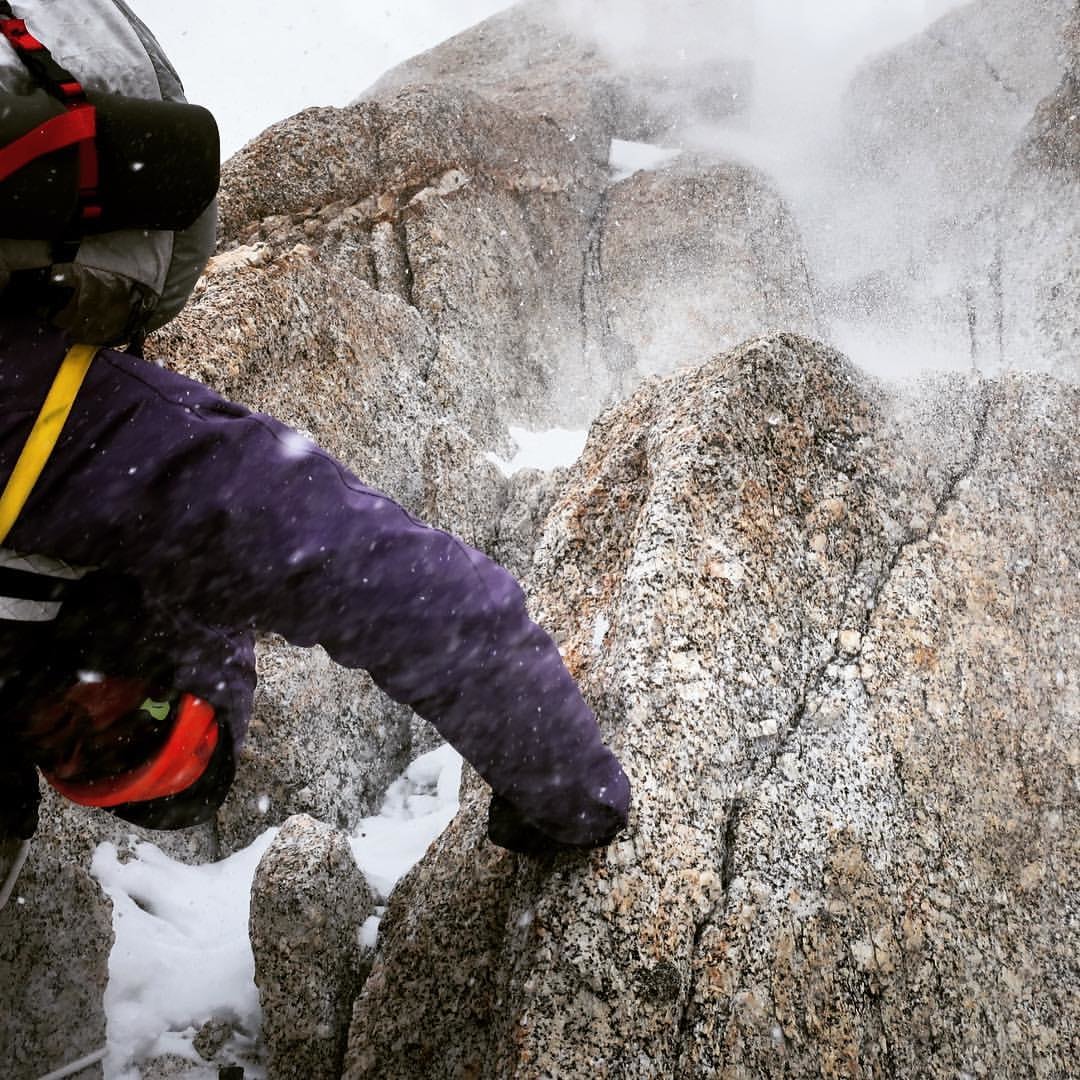

Twenty hours later, the winds remained but the visibility had improved enough for us to move. Simul’ing up to the crux step of the first rock band, it became apparent how much new and wind-transported snow had accumulated. With nowhere to go but up, we weaved our way through the path of least-resistance and managed an ideal route up fresh snow and intermittent mixed climbing through the first rock band. The broken mixed climbing would have been enjoyable, but much of the terrain was exposed to the wind. It began snowing about halfway through, and we were forced to move quickly with minimal protection to avoid shivering.
Weaving back in off the ridge crest, the first rock band finally gave way to the steep snow slopes leading up to the base of the second rock band. We waded through waist-deep snow as it fell heavier and the winds increased. Avalanche red-flags were everywhere; shooting cracks, collapsing, whoomphing … these slopes exhibited all the signs I’d been trained to avoid in my years of avalanche education.
Worried we’d soon be spit off the face, my rational mind freaked. “These slopes are super loaded,” I yelled to Sam. “Good observation, man,” he asserted back. “What are we going to about it?”
I realized his point. We had no choice but to keep moving at all costs whenever possible. The conditions were far from ideal, and the rest of the climb wouldn’t be safe. Survival was our primary concern. With that, I ignored the slope’s warnings and silenced my mind. Up we went.
We could barely move by the time we reached the base of the second rock band at 15,700 feet. Winds raged, snow dumped, and visibility was horrendous. We chopped out a marginal ledge, and I equalized cams to anchor into as Sam battled frozen hands setting up the tent guylines.
This was the full Alaska experience—one we would not soon forget.
I updated Alan on the inReach with the following message: “Bivying at the base of the second rock band. Storm is RAGING. So windy and cold. Love this shit.”
After many futile efforts attempting to brew with an open tent to avoid carbon monoxide (CO) poisoning, we zipped the tent and brewed inside. Holding the stove in my lap, I was nearly asleep by the time the snow had melted. Realizing our close call, we unzipped the tent immediately, but it was too late. While we struggled to breathe and suffered the effects of carbon monoxide poisoning at altitude over the next few hours, 70mph winds and heavy snowfall combined to build a five-foot wall of snow against the tent entrance. We punched out enough to get outside and dig out the taco’d tent, repeating the process hourly over the next twenty.
Aside from a few gels, we were out of food. My 10º down sleeping bag and Sam’s 0º bag were soaked, and it was -20ºF outside. The weather hadn’t improved, but we needed to get out of there. “Moving soon, forecast bad 🙂 ,” I messaged Al. “Be careful out there dudes. Get sendy.”
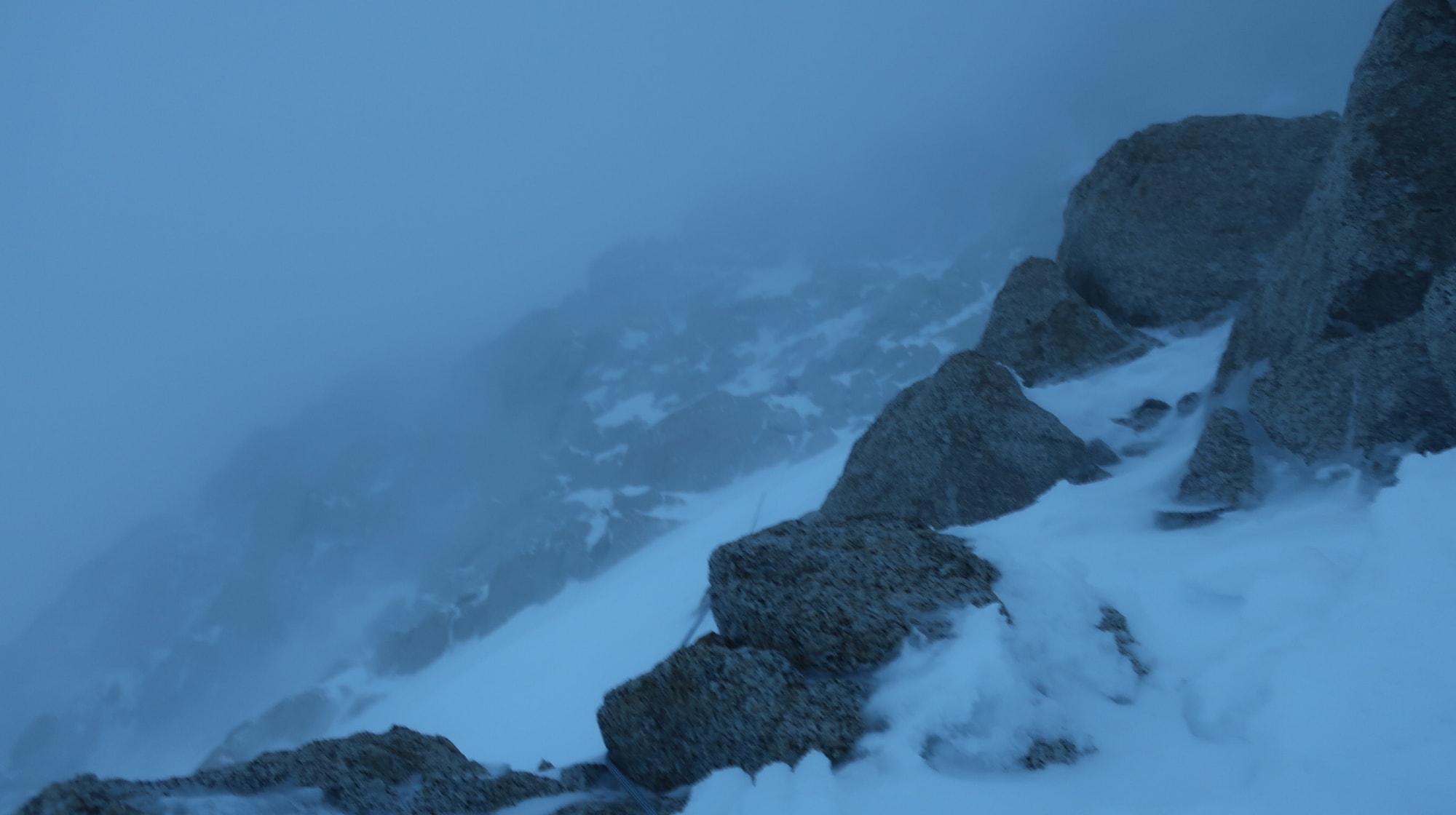
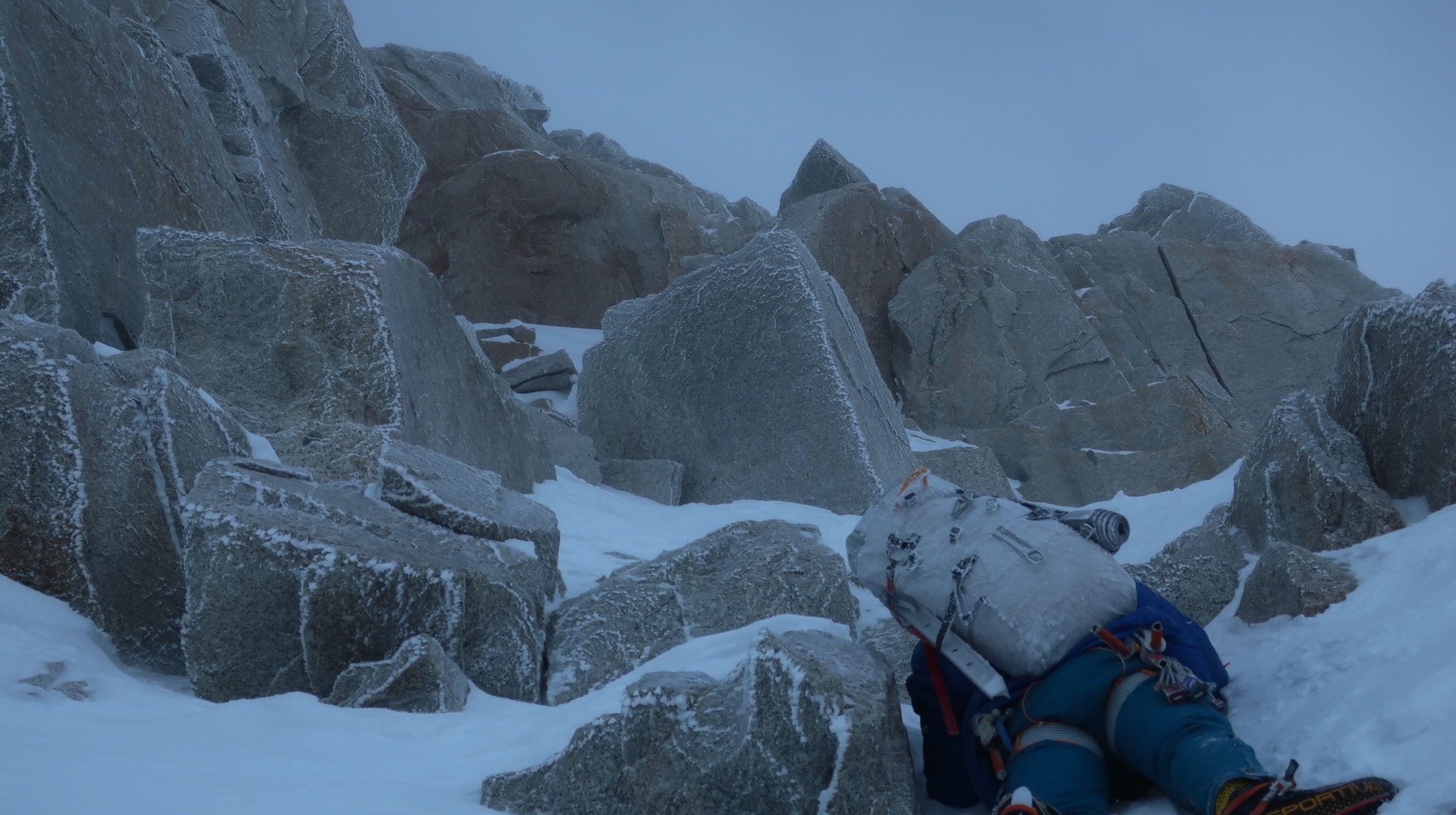
The weather deteriorated further as we picked our way into the entrance of the steep second rock band. We shivered our way up incredible Scottish-esque mixed climbing—huge holds, fantastic steep rock, and perfect sticks. Spindrift and debris pummeled at us throughout, and my memories primarily involve the worst screaming barfies I’ve ever experienced.
We topped out on an exposed slope (16,700 feet) at the end of the technical climbing, and immediately began simul’ing across steep, exposed, and horrifyingly loaded slopes on the edge of Big Bertha (a massive hanging glacier) and up couloirs to the upper ridge. Just before gaining the upper ridge, the weather once again took a turn for the worse.
We were soon fighting to stay on our feet, and forced to bivy on a sloping ledge next to a crevasse. I took out the inReach and read the update from Al: “Mark just called me from 14 and I gave him your inReach number to give to Westman. 70mph winds are forecasted over the next two days. Make sure you sink a picket or screws and tie into that shit. Don’t go Wizard of Oz on us.”
Our spirits were high, and we sang our favorite Beastie Boys tune over freight-train winds as my nose began bleeding. I wondered how badly my toes were frostbitten.
The first break in the winds came over twenty-four hours later. Packing up for our final push up and over Denali’s 20,320 feet summit and down the West Buttress back to 14k, we were rewarded with stunning views. Our position, now apparent, was spectacular and proud. Below us, Mt. Hunter and Mt. Foraker jutted out through the clouds. Above, the sun beamed upon blue skies laced with magnificent white streaks.
For a moment, everything made sense, and the scene offered a reminder as to why we were there. In that brief moment in time, it all seemed worth it.
A gust of wind reminded us we needed to get out of there, and we began punching up the steep, loaded upper slopes. The last 3,000 feet to the summit were every bit as soul-sucking and tiring as we expected. The snow was neck-deep in places, making upwards progress seem nearly impossible. We dug deep as the weather deteriorated.
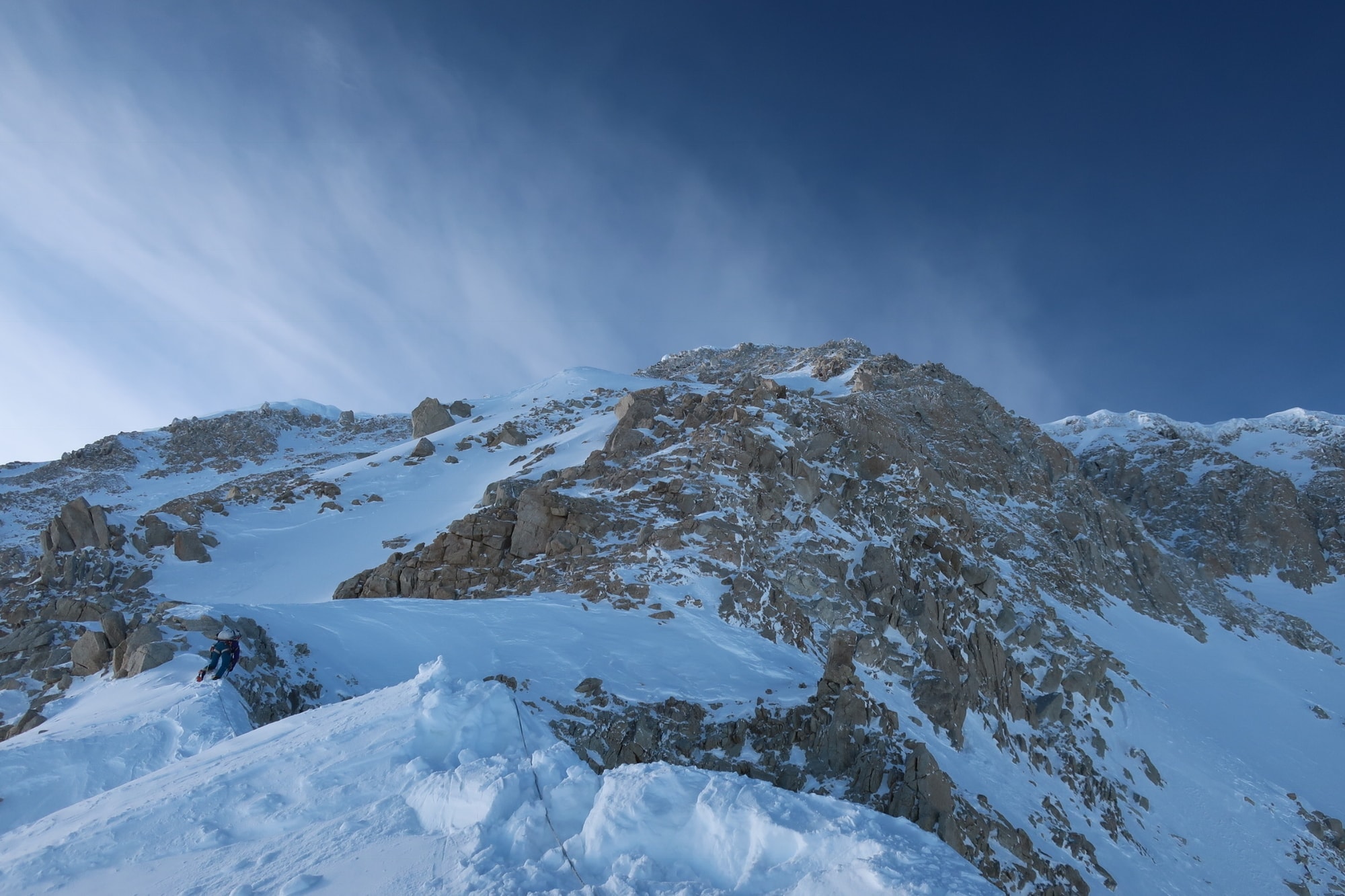
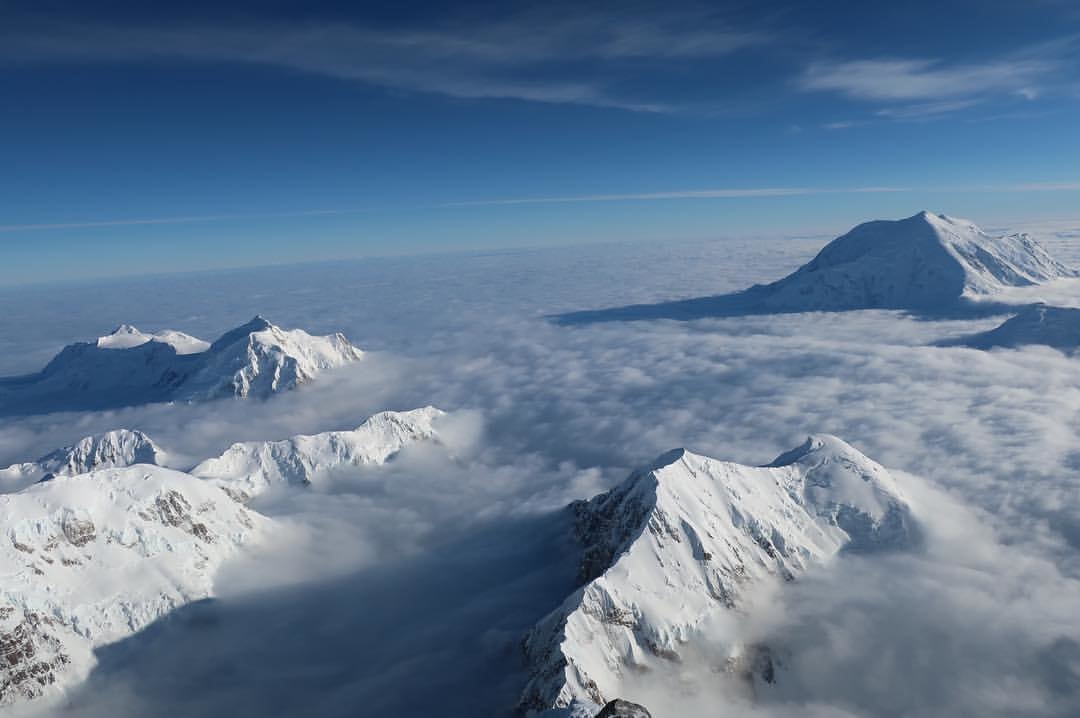
When we finally topped out the Cassin at over 20,000 feet and walked the short distance to Denali’s 20,320-foot summit, we were in a complete white-out coupled with raging winds and heavy snowfall. Despite our familiarity with the West Buttress descent, conditions were about as bad as possible. We dug in to a final forced bivy on top, and Sam promptly became hypothermic.
I took off my mitten and focused my energy into lighting the stove to make Sam a warm water bottle, despite the inherent frostbite that would result. We cuddled and shivered for the next ten hours, at which point we decided to make a break for it. Visibility had improved, and we wallowed down-barren slopes through bitter wind to the 17k West Buttress high camp. No teams had summited while we were on route, and the usual tracks marking the heavily-traveled West Buttress were completely covered. We put the rope away and hurried down to our food stash waiting at 14k, enjoying fantastic views down the ridge.
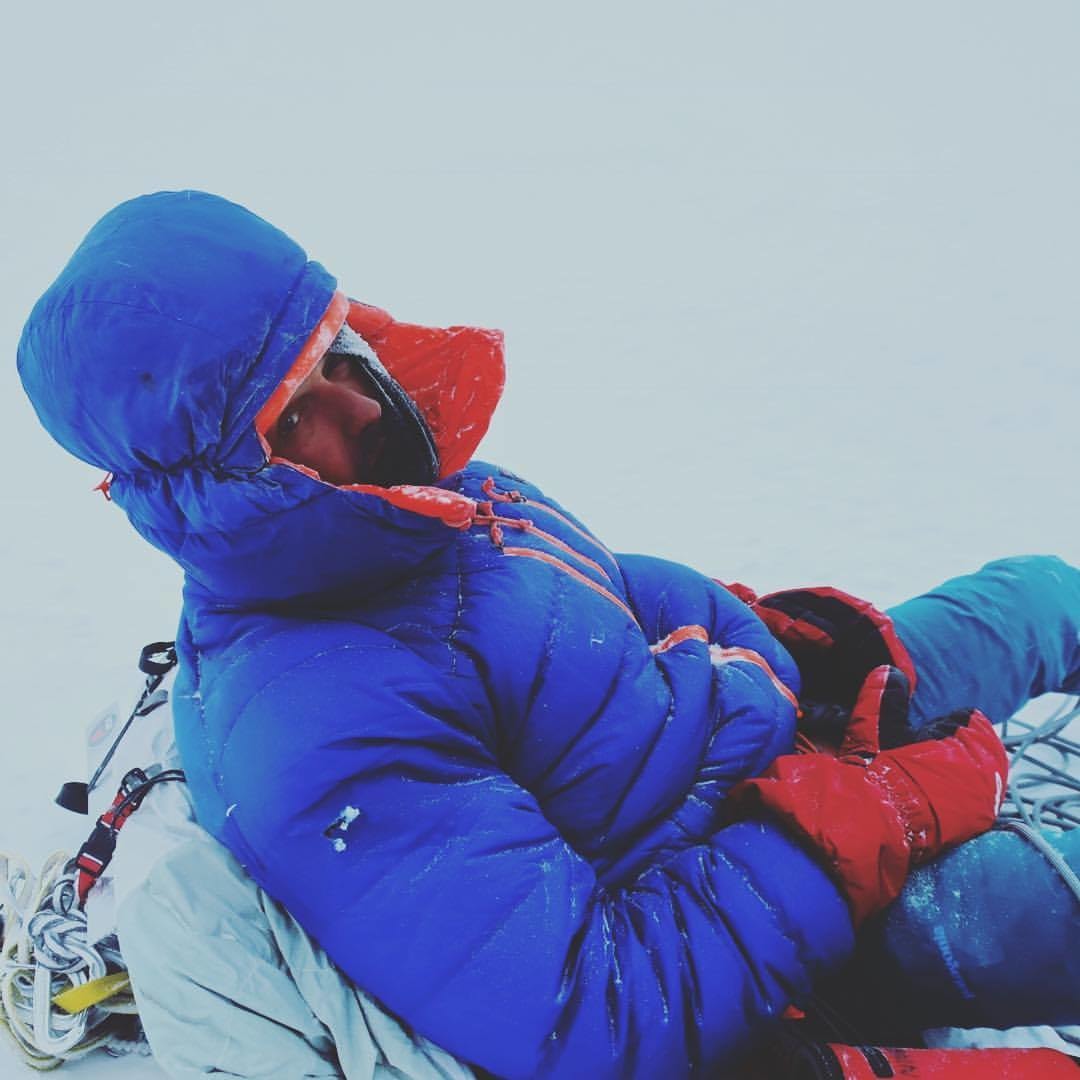
Nearly two months have passed since our trip. I sustained frostbite in my right big toe, all toes on my left foot, and all digits on my right hand. Miraculously, my fingers healed quickly and fully, and I’ve even been able to hangboard for the past month. My right big toe is nearly healed, and my left big toe—the worst of it all—is in the final stages of recovery.
I’m still in Tevas, and although I haven’t been able to rock climb this summer, I’ve enjoyed solitude and happiness in the hills with my dog Dyno, in addition to quality time with family and friends. Sam and I remain close. He recently began a new nursing job, and I am on track to medical school. I look forward to lots of rock climbing with Sam and all my amazing climbing partners once the frostbite heals.
I’ve thought a lot since being back. We were about as out there as we could have been. Through this, I’ve realized an important point.
If you roll the dice and hang it out there often enough, chances are you will eventually get burned. Grand adventures in the mountains are powerful and important experiences—but we gain nothing unless we come home.
Cheers, and remember to embrace it all.
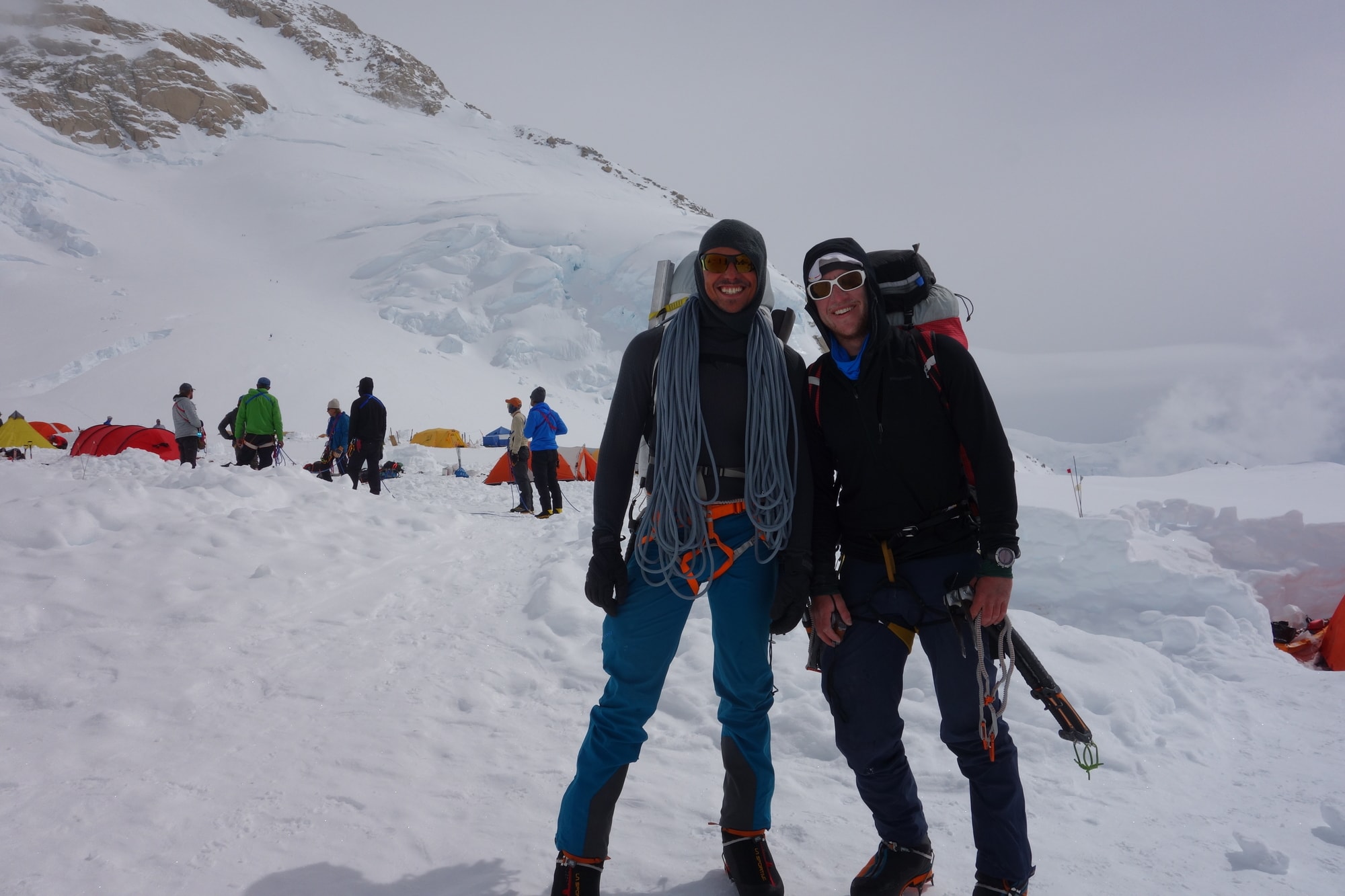
This trip was possible thanks to an American Alpine Club Mountaineering Fellowship Grant and support from CiloGear, Feathered Friends, Gnarly Nutrition, Honey Stinger, Josh Dees, MSR, SCARPA, Taos Mountain Energy, and Western Mountaineering.
Explore More
Related articles you'll loveOur 40+ most popular articles ever
Today’s Best Rock Climbing Gear Deals
200+ rock climbing videos
6 Tips on Being a Good Climbing Partner
Essay: What a Long, Strangely Normalized Trip It’s Been—The Role of Counterculture in Climbing
“I Will Climb, Too” — A Story on Mentorship and Responsible Climbing
Book Review: Hans Florine’s On The Nose
How to Climb in Yosemite: Gear, Essentials, and Other Tips
The 5 Best Friends to Have at the Crag
Climbing History: Free Soloist, John Bachar
Essay: How to Climb When You’re Not Alex Honnold
Pitch 27: A Journey for the The Nose in a Day
Will You Be My Trad Guru?: The Importance of Apprenticing in the Gym Climbing Era
The Joys of Moderate Multi-Pitch … and How You Can Enjoy It, Too!
Get daily updates by Liking us on Facebook
Free rock climbing PDFs on technique, training, knots, and more








